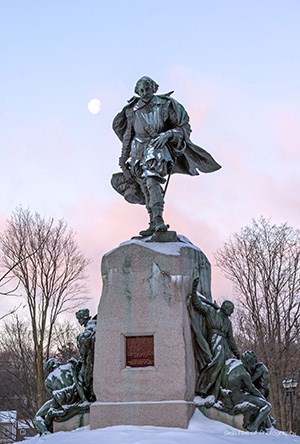OrilliaMatters received the following guest column from former Packet & Times columnist Colin McKim on the debate surrounding the fate of Orillia's Champlain Monument.
********************
The Orillia alderman was outraged.
How dare a government document be presented to council with the French version stapled on top of the English!
It was the early 1990s and the Orillia-based Association for the Preservation of English in Canada (APEC) was telling anyone who would listen they would not have French rammed down their throats. Not one syllable!
This particular alderman, rest his soul, was a staunch APEC supporter and ever vigilant against creeping bilingualism.
At the time I thought the Champlain monument, erected in 1925 to commemorate the friendship between the English and French in Canada, seemed a big contradiction to the rather more hostile attitude expressed in council chambers.
At the Orillia Legion, the mention of Quebec could arouse anger among veterans who believed La Belle Province had shirked its duty in World War II, sending a mere fraction of the young men into battle as English Canada.
Here, too, there was no sense of friendship or comraderie with French Canadians.
Champlain, the Father of New France, may have been a brave and heroic explorer. But his New World descendants, certainly in the minds of many local veterans, were rank cowards.
If APEC believed a 12-foot-tall Frenchman, armed with a seven-foot-long sword, posed a threat to English-speaking Orillians, they never said so. There were no efforts that I recall to erect an even larger statue of General James Wolfe to keep an eye out.
Those anti-French sentiments are consistent with the tribalism and paranoia that infects much of our politics today, particularly in the United States. Trump's Make America Great Again has been a call to arms for white supremacists and some Christian evangelicals.
The dreaded enemy is people of different colours, cultures and religious beliefs. Latinos, Muslims, African Americans...other tribes. Norwegians are still welcome.
In Canada, despite some deep-rooted prejudice, we have pursued a vision of tolerance and multi-culturalism. Thankfully, we don't identify and analyze voters according to racial categories as is common practice in U.S. elections.
The Champlain monument is tribalism writ large.
The grand explorer, the fur-bearing trader and the cross-brandishing priest represent the dominant tribe, each standing high and mighty.
The Hurons, naked except for loin cloths, assume inferior positions at the feet of the white men, passively submitting to the power of commerce and scripture.
The seven figures on the monument completely distort the relationship between Champlain and his Huron hosts, which was one of relative equality and mutual benefit. Two distinct tribes for sure, but brothers in travel, trade and even war.
You might think I am leading up to a call for the permanent removal of the bronze figures from our sight. Not at all.
I believe in equality and oppose discrimination and the demeaning of any person or people. Canadians aim to be better than that.
But I am not disturbed by the Champlain monument because it is not a record of history, but a work of art – the far-fetched, feather-and-fur fantasy of an English sculptor who could only guess at Champlain's appearance and clearly knew little of the explorer's remarkable journey through Huronia in 1615.
How many holes would the bronze Champlain have punched in the bottoms of birch bark canoes or fellow canoeists with those ostentatious spurs?
The four Huron men, handsome and strong-muscled, are, I suspect, the sculptor's idea of the noble savage – an idealized image of man in a natural state, free of the corrupting influence of civilization.
From that perspective, the trader and priest, despite their superior positions, could be seen as detrimental forces – degraders of natural nobility.
And is Champlain, with his broad-brimmed, feathered hat, heavy cape and aforementioned spurs, the crown of creation? Or is he something of a strutting dandy, focused more on affectation and finery than heroic enterprises?
Still, in spite of gross historical misrepresentation and blatant tribalism, the monument is an extraordinary rendering of human beings and by far the most eye-catching feature in the park – public art of the highest caliber.
There are many plaques in the park telling history as we understand it today. More may be needed. And our stated friendship with the French may need to be re- examined.
But don't ask the Champlain monument to look 400 years into the past. History is not its strength.
What Vernon March presents is the intersection of two worlds – two wildly different civilizations coming together in the long last past.
It is a moment as full of portent as the clash of God and man in the Garden of Eden, The seduction of innocence by knowledge. The irreparable loss of our primeval connection to nature.
It's all there in beautifully contoured bronze.
After this monumental meeting captured so brilliantly in March's artistic vision, life on this part of the earth will never be the same.
Colin McKim
Orillia
********************



